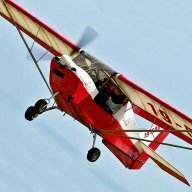Well, even at places like Armidale (YARM) and Taree (YTRE) where servos are just outside the airport fence, you could still have maybe 200 metres, or more, to lug your 40 L of fuel. So , yes, it seems some solution is needed.
I've been nutting out a system for long trips which includes one - or two - 20L bladders plus one rigid 10L plastic can (which I think I just have room for).
I'll use one of those small 6v transfer pumps (4XAA cells) to decant into the 10L can for pouring down the aircraft's filler throat (up on the turtle deck) via Mr. Funnel.
I'll do it that way because I have an aversion to wrangling any 20L fuel container atop a ladder - especially a bladder which may well gush forth at the slightest slip.
Anyway, 20L bladders are easier to handle, when full, than I'd imagined (down on the ground, that is); even sort of standing up by themselves.
And I've found that if they're set down and lashed to the lift strut they're just as secure as rigid ones during transfer pumping
The small battery powered pump routine is slower than just pouring but I find it a calmer, less accident prone method.
And you might only have to use it once since a half empty 20 is but a 10 by default ;- )
Anyway, spurred by your scenario, Freizy, I've now gone for one of these Samsonites on Amazon. Wheels are a bit bigger and it looks a bit tougher than the other one.








